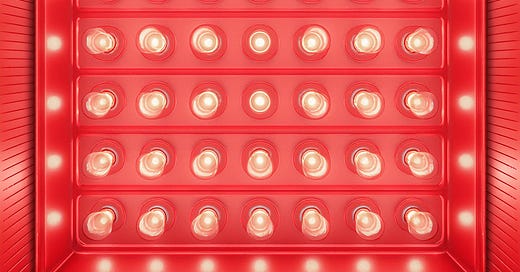Red Light Therapy
TLDR - Red light therapy can enhance skin health, reduce inflammation, and support mitochondrial function. While these devices can be beneficial, natural sunlight should always be prioritized when possible.
What is Red Light Therapy?
Red light therapy, also known as photobiomodulation, involves exposing the body to low levels of red or near infrared light. Unlike UV light, which can damage the skin, red and near infrared light are safe and beneficial. These wavelengths penetrate the skin and are absorbed by the cells, leading to various therapeutic effects.
Benefits
Skin Health: Red light therapy can improve skin health by stimulating collagen production, reducing wrinkles, and promoting wound healing. It can also help with conditions like acne and psoriasis.
Pain Relief: This therapy has been shown to reduce inflammation and alleviate pain, making it beneficial for conditions like arthritis and muscle soreness.
Enhanced Recovery: Athletes and fitness enthusiasts use red light therapy to speed up muscle recovery and reduce fatigue.
Mental Health: Some studies suggest that red light therapy can improve mood and reduce symptoms of depression and anxiety.
Melatonin Production: Red light therapy can influence melatonin production, which is crucial for sleep and overall cellular health.
Different Wavelengths
Red light therapy typically uses wavelengths in the range of 620-750 nm, while near-infrared light falls in the range of 750-1200 nm. Each wavelength has unique benefits:
Red Light (620-750 nm):
Surface Level Benefits: Red light primarily affects the skin's surface. It is absorbed by the epidermis and dermis layers, making it effective for improving skin health, reducing wrinkles, and promoting wound healing.
Collagen Production: Red light stimulates collagen production, which helps maintain skin elasticity and reduce signs of aging.
Near Infrared Light (750-1200 nm):
Deeper Penetration: Near infrared light penetrates deeper into the body, reaching muscles, joints, and even bones. This makes it effective for reducing inflammation, alleviating pain, and enhancing muscle recovery.
Mitochondrial Support: Near infrared light supports mitochondrial function by improving the efficiency of the electron transport chain, leading to better energy production and overall cellular health.
Natural Sunlight
While red light therapy panels offer targeted benefits, it's essential to prioritize natural sunlight. Natural sunlight contains a full spectrum of light, including red and near infrared wavelengths, which provide comprehensive health benefits. Approximately 40% of natural sunlight is red and near infrared light, making it a valuable source of these beneficial wavelengths.
Full Spectrum Benefits: Natural sunlight offers a broader range of wavelengths, providing more comprehensive health benefits compared to isolated red light therapy.
Cost Effective: Sunlight is free and readily available, making it a cost effective alternative to expensive red light therapy panels.
Circadian Rhythm: Exposure to natural sunlight helps regulate the circadian rhythm, improving sleep quality and overall health.
More Benefits
Red light therapy helps to expand the amount of EZ water in the body. EZ water, also known as structured water, is crucial for cellular health as it provides a stable environment for biochemical reactions and helps to maintain cellular integrity.
EZ water is more structured and organized than regular water, which makes it more effective at hydrating cells. Red light therapy helps to increase the levels of EZ water, thereby improving cellular hydration and overall cellular function.
EZ water has the unique property of excluding toxins, pathogens, and other unwanted substances from the cellular environment. By increasing the amount of EZ water, red light therapy aids in detoxification processes, helping to keep cells clean and functioning optimally.
Blood Flow and Circulation:
EZ water plays a role in driving flow processes in the body, such as blood and lymphatic circulation. Red light therapy can help to improve these flow processes by increasing the amount of EZ water, thereby supporting better nutrient delivery and waste removal.
Both red and near infrared light enhance mitochondrial function by stimulating the production of ATP, the energy currency of the cell. This leads to improved cellular energy and overall health.
Near infrared light helps mitochondria produce melatonin, a powerful antioxidant that protects cells from oxidative stress and damage.
Melanin:
Melanin is the pigment responsible for skin color and provides protection against UV radiation. Red light therapy can stimulate melanin production, enhancing the skin's natural defense mechanisms.
Melatonin:
Near infrared light helps mitochondria produce melatonin at the subcellular level. This melatonin acts as a potent antioxidant, cleaning up cellular damage and reducing inflammation throughout the day.
While red light therapy can boost melatonin production, it's essential to use it at the right time. High intensity red light in the evening can suppress melatonin production from the pineal gland, potentially disrupting sleep. It's recommended to use red light therapy earlier in the day to avoid interfering with nighttime melatonin production.
Potential Concerns
While red light therapy devices offer numerous benefits, there are several concerns to consider. One major issue is the emission of non native EMFs, which can potentially disrupt cellular function and contribute to health problems over time. Additionally, many red light therapy devices have a high flicker rate, which can cause eye strain and stress the nervous system, particularly with prolonged exposure. Another significant concern is that these devices do not provide the full spectrum of sunlight, which includes a range of wavelengths essential for various physiological processes. As a result, relying solely on red light therapy devices may lead to an imbalance in light exposure, underscoring the importance of prioritizing natural sunlight whenever possible.



